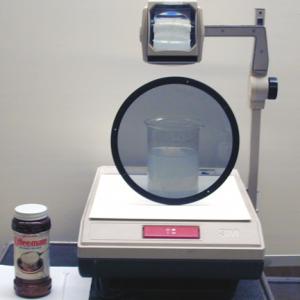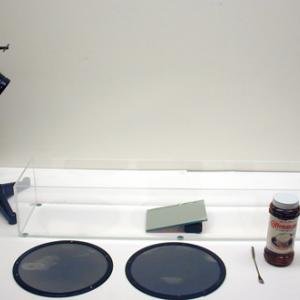College of Liberal Arts & Sciences
6H50.10 - Polarization - Scattering
Place masking plate with the 1.5" diameter hole on the overhead projector. Over the hole in the masking plate place a beaker of water that contains some milk or non-dairy creamer. If this is added without appreciable stirring the light emitted from the side of the beaker should be polarized.
Put the pinhole slide into the slide projector and then set the projector so that it points into the tank at an angle. The mirror in the tank is also set at an angle so that a round oval of light is projected onto the ceiling. Due to the index of refraction between the air and the water one of the rims of the oval is red and the other is blue or violet. Now if you add a few drops of milk or coffee creamer, the milk particles add scattering and as the shorter wavelengths are scattered most the rims start to change colors. If the right amount of milk is added the blue rim goes from violet to green.
The above experiment can also be used to show forward and back scattering. Add the milk or coffee creamer to the water. Instead of using the projector, shine a laser through the tank. If you look at the tank from the laser position or the side you will see some back scattering. If you look at the beam from in front of the laser you will see that the forward scattering is much more intense than the back scattering.
A more complicated way to create the scattering particles is to make two solutions. Solution 1 is 25 g of sodium thiosulfate in 500 ml of distilled or filtered H20. Solution 2 is 1.5 ml of concentrated HCL to 500 ml of water. When ready, add the two solutions together on the overhead projector. The transmitted light should go from white to yellow to orange to red and eventually extinction. This process will take about 1 minute. If you wish to slow the reaction time down to about 3 minutes, use only 15 g of sodium thiosulfate when making solution 1. Note that as these two solutions are mixed, it is the colloidal sulfur precipitate that are the scattering particles.
- Raymond E. Benenson, "Light Polarization Experiments with a Diode Laser Pointer", TPT, Vol. 38, #1, Jan. 2000, p. 44.
- Jay S. Huebner, "'A Golden Oldie': Projecting a Sunset", TPT, Vol. 32, #3, Mar. 1994, p. 147.
- Paul Chagnon, "Animated Displays IV: Linear Polarization", TPT, Vol. 31, #8, Nov. 1993, p. 489, Referenced in Resource Letter TLC-1 Teaching Light and Color, Demonstration Experiments Resource Articles.
- G. R. Davies, "Polarized Light Corridor Demonstration", TPT, Vol. 28, #7, Oct. 1990, p. 464.
- John D. McGervey, "Polarization of Scattered Light", TPT, Vol. 24, #7, Oct. 1986, p. centerfold section.
- Craig F. Bohren and Alistair B. Fraser, "Colors of the Sky", TPT, Vol. 23, #5, May 1985, p. 267.
- Wallace A. Hilton, "An Experiment on Sky Polarization and Brightness", TPT, Vol. 16, #5, May 1978, p. 294.
- Glenn S. Smith, "The Polarization of Skylight: An Example From Nature", AJP, Vol. 75, #1, Jan. 2007, p. 25.
- B. G. Eaton and John B. Johnston, "More About Light Scattering Demonstrations", AJP, Vol. 53, #2, Feb. 1985, p. 184.
- D. E. Shaw, F. J. Wunderlich, and M. J. Hones, "Polarization Characteristics of Scattered Light", AJP, Vol. 45, #7, July 1977, p. 638.
- "O-040. Simulated Sunset", DICK and RAE Physics Demo Notebook, 1993.
- Richard Manliffe Sutton, "L-127", Demonstration Experiments in Physics.
- Borislaw Bilash II and David Maiullo, "Why Is the Sky Blue?", A Demo a Day: A Year of Physics Demonstrations, p. 324.
- Jearl Walker, "6.139. Sunglasses and Smog", The Flying Circus of Physics Ed. 2, p. 300.
- Jearl Walker, "6.127. Sky Polarization", The Flying Circus of Physics Ed. 2, p. 295.
- "19. Polarization of Skylight", Clouds in a Glass of Beer.
- "Departures from Complete Polarization", Clouds in a Glass of Beer, p. 150.
- Robert Ehrlich, "O.1. Polarization of Scattered Light", Turning the World Inside Out and 174 Other Simple Physics Demonstrations, p. 171.
- T. D. Rossing and C. J. Chiaverina, "7.4. Polarization By Scattering", Light Science, Physics and Visual Arts, p. 159.
Disclaimer: These demonstrations are provided only for illustrative use by persons affiliated with The University of Iowa and only under the direction of a trained instructor or physicist. The University of Iowa is not responsible for demonstrations performed by those using their own equipment or who choose to use this reference material for their own purpose. The demonstrations included here are within the public domain and can be found in materials contained in libraries, bookstores, and through electronic sources. Performing all or any portion of any of these demonstrations, with or without revisions not depicted here entails inherent risks. These risks include, without limitation, bodily injury (and possibly death), including risks to health that may be temporary or permanent and that may exacerbate a pre-existing medical condition; and property loss or damage. Anyone performing any part of these demonstrations, even with revisions, knowingly and voluntarily assumes all risks associated with them.

